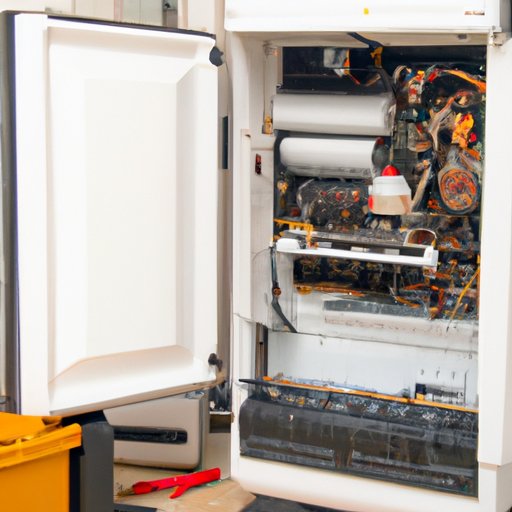Introduction
A refrigerator is an essential appliance in every home, allowing us to store food and drinks at safe temperatures. Unfortunately, refrigerators can experience problems that need to be addressed in order to keep them running properly. In this article, we’ll explore how to troubleshoot and fix common refrigerator issues.
Troubleshooting Common Refrigerator Issues
The first step in fixing a refrigerator is to identify the source of the problem. Some common issues include the refrigerator not cooling or freezing, loud noises coming from the unit, the light not working, and water leaking from the unit. Once you’ve identified the issue, you can explore possible solutions.
Inspect and Clean the Condenser Coils
Condenser coils are located on the back of the refrigerator and help to cool the unit. If these coils become clogged with dust or debris, they can cause the refrigerator to overheat and stop working properly. To inspect and clean the condenser coils, you’ll need to unplug the refrigerator, then use a vacuum cleaner with a soft brush attachment to remove any dust and dirt. Be sure to wear protective gloves and eyewear when cleaning the condenser coils.
Check the Temperature Settings
If the refrigerator is not cooling or freezing correctly, it could be due to incorrect temperature settings. The ideal temperature for a refrigerator is between 37 and 40 degrees Fahrenheit, while the ideal freezer temperature should be between 0 and 5 degrees Fahrenheit. To adjust the temperature settings, locate the control panel inside the refrigerator and use the arrows to set the desired temperature. If the temperature settings are incorrect, the refrigerator may not work properly.
Replace the Door Gasket
The door gasket is the rubber seal around the perimeter of the door that helps keep the cold air inside the refrigerator. Over time, the gasket can become worn out or cracked, which can cause cold air to escape and the refrigerator to malfunction. To replace the door gasket, you’ll need to remove the old gasket and measure the new one to make sure it fits. Then, attach the new gasket to the door using screws or adhesive. Finally, test the gasket to make sure it is properly sealed.
Clean the Evaporator Fan
The evaporator fan helps circulate the air throughout the refrigerator. If the fan is dirty or clogged, it can cause the refrigerator to run inefficiently. To clean the fan, you’ll need to unplug the refrigerator and locate the fan inside the unit. Use a vacuum cleaner to remove any dust and debris, then wipe the fan blades with a damp cloth. Be sure to wear protective gloves and eyewear when cleaning the fan.

Test the Compressor and Relay
The compressor and relay are responsible for powering the refrigerator. If the compressor or relay is faulty, the refrigerator will not work properly. To test the compressor and relay, you’ll need to unplug the refrigerator and locate the components. Use a multimeter to test the components for continuity. If either the compressor or relay is faulty, you’ll need to replace it.
Conclusion
Fixing a refrigerator can seem intimidating, but with some basic troubleshooting knowledge, you can diagnose and repair most common issues. From inspecting and cleaning condenser coils to replacing the door gasket, these steps can help get your refrigerator up and running again. However, if you’re unable to resolve the issue on your own, it’s best to contact a professional for assistance.


